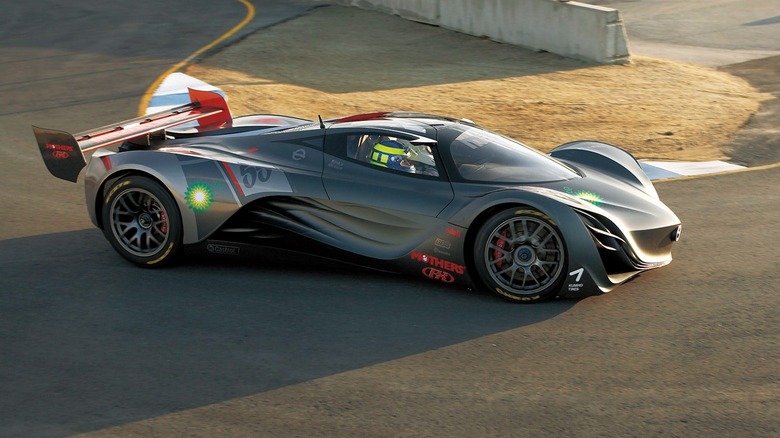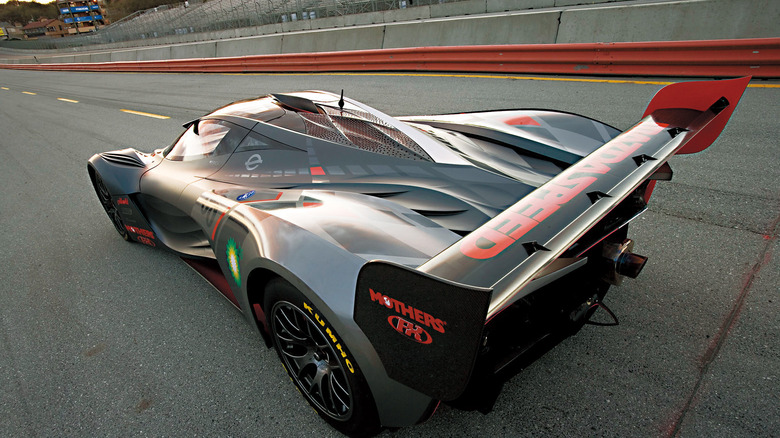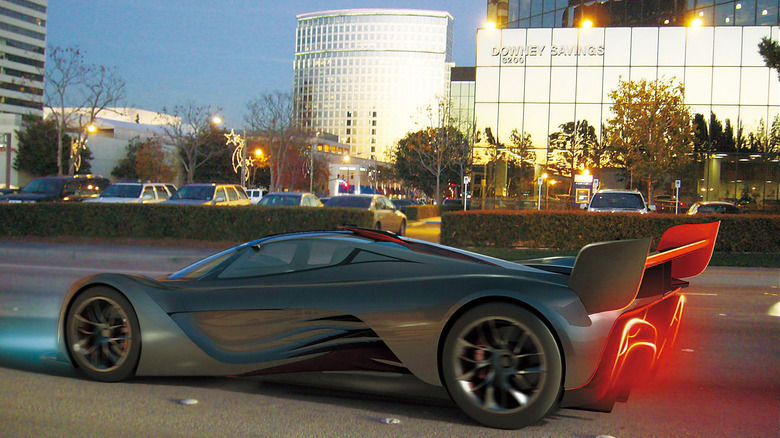What Happened To The Mazda Furai Concept Car?
The Mazda Furai — or "Sound of the wind" — was one of the most striking concept cars of the 2000s, an absolute treat from the perspectives of form, function, and feeling. It was first revealed at the 2008 North American International Auto Show in Detroit and earned widespread praise for its representation of Mazda's new design direction, "Nagare." The word is Japanese for "flow" or "stream" and is commonly used to describe, for instance, a stream of consciousness or the passage of time. The Furai's design evoked this sense of continuous flow with a fluid cascade of curves and angles, giving it a unique and striking look. This design language endeared the Furai to enthusiasts the world over. Sadly, the Furai met its end as dramatically as it entered: in a roaring fire which erupted from the engine bay behind the seats.
Staffers from Top Gear Magazine were shooting footage in August 2008 when photographers noticed licks of flame coming from the exhaust; a common sight in high-powered rotary-engine cars. Larger flames consumed the rear end shortly after, and because the car was over a hill from where the fire marshals were posted, they weren't aware of the blaze until it was far too late. The charred remains of the Furai were quickly hauled away and shipped to Mazda's advanced design studio in Irvine, California, and that's the last we've heard of it. Mike Fernie of Drivetribe published a response from Mazda to a 2024 email he sent regarding the Furai, which bluntly read, "We cannot share the location of the concept." To this day, no one knows where the Furai is or what Mazda's future plans are for the model.
What was the Mazda Furai?
There's a good reason why the Furai handled so well, and that's its remarkable chassis. Underneath its shell, the Furai was essentially a Courage C65 LMP2 fitted with a three-rotor powerplant and XTrac 6-speed sequential manual gearbox. As such, it had the underpinnings of a highly-tuned racing machine meant to compete in the 24 Hours of Le Mans, complete with running gear, lightweight carbon fiber monocoque, and single rear exhaust. According to Mazda, the Furai was meant to bridge the gap between a road-going car and a race car like nothing had done before. So it's appropriate to think of this vehicle as analogous to other legendary homologation specials that used racing chassis: the Toyota GT-One, Porsche 911 GT1, and Nissan R390.
The Furai's 20B rotary engine only produced 450 horsepower, but its lightweight, race-tuned underpinnings meant it was extraordinarily fast around a circuit. The engine used E100 ethanol, a choice inspired by Mazda's drive towards environmentalism and sustainable fuels. The uniquely-shaped bodywork also captured the imaginations of many motorists, and was certainly boosted by the Furai's inclusion in popular video games. The Furai's form was to represent Mazda's Nagare design language by evoking the movement of air or water. The resulting structure was unlike almost anything fitted to a racing chassis before or since, with some of the most geometrically complex structures seen in automotive bodywork. Even the headlamps and taillamps were mesmerizingly beautiful, like sci-fi-inspired kaleidoscopes of light.
The untimely end of the Furai
There's no official press statement by Mazda confirming the exact cause of the Furai's fire, so this portion of its story remains educated speculation. That said, we know various factors may have influenced its demise, starting with the fuel. E100 racing fuel is a highly-flammable solvent which contains high concentrations of ethanol and traces of methanol. Top Gear's photographer noticed open flames coming from the exhaust and saw that the fire started in the rear of the car before moving forward with the wind. High-performance engines generate extraordinary amounts of heat, which is why certain cars feature specialized thermal elements around the radiator.
For instance, the 230-mph McLaren F1's engine bay uses gold foil as a heat deflector. The Furai, meanwhile, featured low-profile bodywork coupled to an experimental powertrain, fueled by essentially pure alcohol. This combination could have generated excessive heat where the vapor was strongest, and the photographer noted that the car sounded strange when it approached a corner prior to its demise. This sound might have been caused by fuel lines melting or wires or other electrical elements failing, either of which could result in a noticeable sputter. But as we mentioned before, no one outside Mazda really knows what became of the Furai after it burned up.
There have been rumors circulating online of an RX revival, along with the emergence of Wankel-powered concepts like the Iconic SP and virtual RX-Vision. Mazda also recently revived its rotary engine development group in tandem with bringing back rotary power in the form of range extenders on electric vehicles. So while the future of the rotary engine looks as bright as the flames that consumed the Furai, whether the LeMans-inspired model will be a part of that future is anyone's guess.


